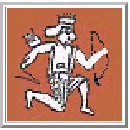
** I disegni dei Siglos di Carradice (1987) sono stati utilizzati anche per segnalare le pagine di questo sito. Questo perché sono estremamente indicativi delle loro variazioni susseguitesi nel tempo.
 ABSTRACT
ABSTRACT
The Achaemenid Empire began in 648 BC, and at the height of its power spanned over three continents from the Indo to Aegean seas, to the Persian Gulf and as far as Egypt. Its greatest expansion resulted from the conquests of Cyrus II° the Great (the 558-528 B.C), Cambyses II° (529-522 B.C.) and Darius I° (521-485 B.C.). Cyrus II°, the true founder of the Empire, was greatly appreciated by his conquered subjects due to his respect of their politics and religion. Cambyses II° subsequently widened the borders of the Empire. Darius I°, followed Cyrus II°’s expansionistic policy and took care to maintain the organization and administration of the territories, improved communication and encouraged internal trade. Naval and land forces were increased in preparation for further conquests. In the 490 B.C the Empire attacked Thrace and the Macedonians but it was defeated by the Greeks at Marathon. The same fate befell Xerses I° (485-465) who was defeated by Temistocles at Salamina. Thereafter the Empire went gradually into decline until Darius III° was defeated by Alexander III° (the Great) in the battles of Isso and Gaugamela which marked the end of the Empire and of the Achaemenid Dynasty in 330 B.C.
The Achaemenid coinage is very characteristic. On the silver sigloi (weight approximately 5.50 g), the obverse shows the Great King armed with bow and spear, symbols of power, or with akinakès, the short typical dagger of the Persians. The reverse bore numerous countermarks testimony to their accepted circulation. The rarer gold daric also used the same representation of the Great King to the right. Four fundamental coinage types are known, classified by design with further subdivisions. All these coins are rather rare.
 RÉSUMÉ
RÉSUMÉ
L'Empire Achéménide, qui débuta en 648 av.J.C., s'étendit sur trois continents au sommet de son développement: de l'Inde à la mer d'Égée, au Golfe Persique et jusqu'en Égypte. Sa plus grande expansion origine des conquêtes de Cyrus II le Grand (558-528 av.J.C.), de Cambyse II (529-522 av.J.C.) et de Darius I (521-485 av.J.C.). Outre le fait que Cyrus II fut le vrai fondateur de l'Empire, il fut aussi grandement apprécié des peuples conquis en respectant leurs politiques et leurs religions. Cambyse II élargit les frontières de l'Empire. Pour sa part, Darius poursuivit la politique d'expansion mise de l'avant par Cyrus II, tout en se préoccupant aussi de l'organisation et de l'administration de tout le territoire: il améliora les voies de communication, développa les échanges commerciaux internes et externes et, en même temps, il favorisa le domaine des arts. De plus, les armées de terre et de mer furent renforcies en préparation de futures conquêtes. En 490 av.J.C., Darius attaqua la Thrace et la Macédoine, mais il subit la défaite aux mains des grecs à Marathon. Xerxèx I ( 485-465 av.J.C. ) subit le même destin en étant défait par Thémistocle à Salamine. Par la suite, l'Empire vécut son déclin jusqu'à Darius III qui fut défait par Alexandre III, roi de Macédoine, dans les batailles d'Issos et de Gaugamèles: ceci marqua la fin l'Empire et de la dynastie des Achéménides, en 330 av.J.C.
Le monnayage achéménide est très charactéristique. Sur les siglos en argent (poids approximatif de 5.50 g ), l'avers montre le Grand Roi avec un arc et une lance, symboles de puissance, ou encore avec l'akinkès ( la courte dague typique des Perses). Au revers, diverses contremarques témoignent d'une large utilisation de ces monnaies. Le daric, rare monnaie d'or, présente sur l'avers la même représentation du Grand Roi. Pour tout le monnayage, on ne connait que quatre types fondamentaux, classifiés par dessins, avec plusieurs subdivisions. Toutes ces monnaies sont plutôt rares.
 RIASSUNTO
RIASSUNTO
L'Impero Achemenide, iniziato nel 648 a.C., si è sviluppato raggiungendo un'estensione che andava dall'Indo all'Egeo, al Golfo Persico, fino all'Egitto. La sua massima espansione fu raggiunta con le conquiste di Ciro II° il Grande (558-528 a.C), di Cambise II° (529-522 a.C.) e di Dario I° (521-485 a.C.). Il primo, oltre che essere il vero costruttore dell'Impero, fu molto amato perchè rispettò la politica e la religione dei popoli sottomessi. Il secondo ampliò i confini dell'Impero. Anche Dario I°, pur con una politica espansionistica, seguì le orme di Ciro II°, ma si occupò anche dell'organizzazione e dell'amministrazione di tutto il territorio facilitando le vie di comunicazione, incrementando gli scambi commerciali interni ed esterni, e prediligendo nel contempo le opere d'arte. Nè venne trascurata la preparazione militare sia in terra che in mare. Nel 490 a.C cercò anche di conquistare la Tracia e la Macedonia, ma fu sconfitto dai Greci a Maratona. Uguale sorte toccò a Serse I° (485-465), sconfitto da Temistocle a Salamina. L'Impero andò via via degradando fino a Dario III°, sconfitto da Alessandro III° il Macedone nelle battaglie di Isso e Gaugamela che segnarono la fine dell'Impero e della Dinastia achemenide nel 330 a.C.
La monetazione achemenide è assai caratteristica. Si riscontrano i siglos d'argento del peso di circa 5.50 g, che presentano al diritto il Gran Re munito di arco (con lancia, simbolo di potenza, oppure con l'akinakès, la corta draga tipica persiana), ed al rovescio numerose contromarche, testimonianze di un'ampia circolazione. Presenti pure i darici d'oro, più rari in quanto meno circolanti, ma presenti con la stessa rappresentazione del Gran Re al diritto. Di tutta la monetazione si conoscono 4 tipi fondamentali, diversificati per immagine, e relativi sottomultipli. Tutte queste monete sono piuttosto rare.
Gli Autori desiderano ringraziare Marc Pelletier e David Stuart per la revisione in lingua madre degli "abstracts" e per le sostanziali e costruttive critiche "navali" e "battaglie" dell'amico Massimo Giacomazzo.



 ABSTRACT
ABSTRACT RÉSUMÉ
RÉSUMÉ RIASSUNTO
RIASSUNTO




